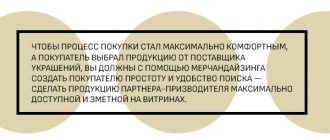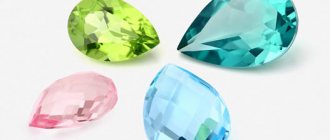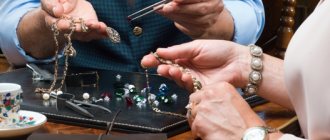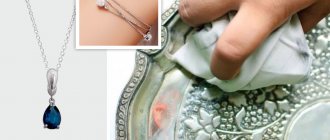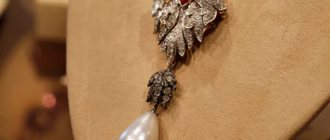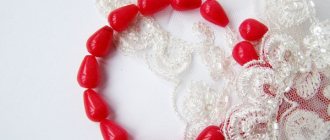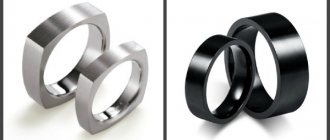Bracelet
Wrist jewelry. They are divided into monolithic and wicker. In the first case, the bracelet is threaded through the wrist, in the second, it is fastened. Bracelets can be worn as an independent decoration, or they can be complemented with several, creating layers. In the photo - a bracelet from Cartier, a very interesting piece of jewelry: The history of a legendary item: the most coveted bracelet in the world - Juste un Clou Cartier
Cufflinks
It is believed that the first cufflinks appeared at the turn of the 16th-17th centuries. in France. It was then that the cut of the sleeves of men's shirts changed: to tighten them, small slits began to be made in the cuffs, through which a pair of identical buttons connected by a chain or wire were threaded. At first they were called cuff buttons, and a little later cufflinks. The widespread use of cufflinks began in the mid-19th century. with the advent of the modern look of shirts with stiff cuffs. They are usually worn with both business and evening suits. Depending on this, cufflinks are made from various (including precious) materials, and the design uses engraving, filigree, niello, and enamel. At the turn of the XIX-XX centuries. There was a mandatory ceremonial set of men's jewelry - a pin for a tie or scarf, buttons, sometimes complemented by a ring, and of course, cufflinks. And at the beginning of the 20th century, when shirt-cut blouses appeared, women began to wear them.
The decor of cufflinks has changed several times over the past 100 years. In 1920-1930 On the cufflinks, horse racing and sports cars coexisted with scenes and trophies of hunting and fishing. In 1960, ethnic motifs inspired by hippie culture were added. In the middle of the 20th century. 2 types of cufflinks were finally formed - European, with identical decoration of both halves, and American, simplified, with decoration of only their front part and small hinges and loops. Nowadays, cufflinks are still relevant, and this is due to the formation of a new psychology, according to which a suit, jewelry and accessories provide an external characteristic of a person’s status in society.
Ring
Finger decoration made of precious metals, sometimes with the addition of stones. Worn as decoration or a symbol of marriage. There is also a cocktail ring, you can read about it here: When you want a holiday: cocktail rings are the main jewelry trend of the season
One of the most iconic rings: A thing out of time: why the Trinity Cartier ring contains the secret to a happy marriage
Brooch
A brooch is one of the oldest decorative elements of costumes of people of all times and peoples. The ancestor of the brooch is considered to be the fibula, which was used by many peoples of the world. The loose and fluffy Renaissance costume made the brooch an indispensable accessory. They were worn by people of different classes - bronze cast ones decorated the modest clothes of the common people, and wealthy nobility ordered precious brooches from jewelers. They were sewn not only on clothes, but also on hats. Thus, in the portrait of the English king Henry VIII by Hans Holbein the Younger we see eight large gold, richly decorated brooches sewn onto the folded brim of the royal hat.
The wide distribution of these jewelry was suggested by the 17th century. The brooch again acquired its utilitarian meaning. With its help, they fastened the collar, gathered the folds of clothing or reduced the neckline, as was done by one of the court ladies of Louis VIII, Madame de Sevigne, whose name has since been borne by this type of brooch. Rubies, emeralds, sapphires, and pearls were used to decorate them.
In the 18th century Diamond brooches appeared in the form of various flower bouquets and bows. At the end of the century, brooches with enamel miniatures, often portraits, became widespread; Cameos and intaglios carved on stone or lava in a strict frame with a needle-shaped lock. They were often replaced by ceramic cameos, which then became fashionable, created at the manufactories of the English ceramic artist Josiah Wedgwood.
Earrings
Ear jewelry that comes in many varieties. Also popular with men, especially as a mono earring.
Popular types:
Studs are small minimalistic earrings with a head decorated with a stone. Carnations are placed when ears are pierced.
Mono is a trendy subtype, with only one accent earring in the look, most often a large one.
Rings (hupas) are thin, round earrings that come in different sizes: both very miniature and large, into which you can thread your hand.
Studs - many do not see the difference between studs and studs. The brightest model of studs is with two balls: a small ball is attached behind the earlobe, and a larger ball is attached in front of the earlobe.
And here are some cool drop earrings: the Chopard earrings that made diamonds dance
Style of jewelry
In addition to the materials used for production, the artistic style of its execution is often taken as the basis for the classification of costume jewelry. The following areas are currently most widespread:
Vanguard . Being the embodiment of designer fantasies, such jewelry is made from the most unexpected materials. It is simply impossible to remain unnoticed in them, since they look very extraordinary.
Avant-garde style jewelry
Art Deco . The distinctive features of jewelry of this style are geometricity, color contrast, ethnic motifs, symmetry, and special cutting of stones and crystals. The most famous models of this trend are tassel earrings, collar necklaces, and bracelets with clear patterns. Such jewelry is the choice of self-confident people who skillfully combine luxurious extravagance with aristocratic restraint.
Art Deco style jewelry
Vintage . These are stylish pieces that showcase the best features of the recent past, but are focused on modern trends. Costume jewelry of this trend is traditionally represented by massive brooches, cameos, bracelets, pendants and medallions, consisting of many miniature parts woven into elegant and sophisticated compositions.
Vintage style jewelry
Glamor . This category offers a wide variety of jewelry from eye-catching hair clips to exquisite cufflinks. All of them are distinguished by demonstrative luxury and an abundance of radiant shine. The main role here is given to rhinestones of a wide variety of colors and sizes.
Jewelry in glamor style
Classic style . This is elegant restraint and luxurious conciseness. This type of jewelry resembles items from jewelry stores. The only difference is in the materials used - artificial pearls, imitation precious stones and expensive metals.
Classic style jewelry
Minimalism . A rather ascetic direction with a small amount of details, simple shapes and discreet shades. As a rule, these are modestly laconic bracelets, stud earrings and thin chains under the neck.
Jewelry in minimalist style
Art Nouveau (Art Nouveau) . This is an amazing kingdom of natural beauty, captured using various alloys, jewelry enamel, amber, glass and ornamental stones. Such decorations impress with the play of color, elegance of shapes and fine lines. Among the jewelry of this style you can find amazing and original images of flowers, plants, birds, animals, and insects.
Jewelry in Art Nouveau style
Youth style . Formed relatively recently, this direction is intended exclusively for young and cheerful people. Such jewelry is distinguished by its bright colors, naive romance and symbolic images.
Jewelry in youth style
Retro . Jewelry in this style carries echoes of early Hollywood fashion, helping to create distinctly feminine looks using intricate shapes and the most unexpected variations.
Retro style jewelry
Ethnic style . These are unusual jewelry with a predominance of oriental motifs. Bright and expressive, made mainly from natural materials (wood, metal, leather, feathers, beads, ornamental stones), they demonstrate the national character, preventing them from getting lost in the crowd.
Jewelry in ethnic style
Necklace
A necklace (French collier – “collar”, “necklace”) is a fairly voluminous decoration for the neck and chest with a fixed and effectively designed central part, which differs from a necklace. However, recently the boundaries of both definitions are often blurred. A necklace can consist of one or several rows of decorative elements, the volumes of which, as a rule, increase towards the center, although asymmetrical compositions of a fantasy nature are also known. Necklaces are often complemented with pendants made of precious stones or large pearls. Unlike the half-choker, which is a relatively small decorative element in the center, the necklace occupies the entire upper part of the chest, turning into a thin strip at the level of the neck and shoulders.
Unlike a necklace, the choker came into use only during the Renaissance. Then it was part of both women's and men's formal dress, and the men's necklace was worn over clothing. It was massive and ended with a large pendant - a medallion. The types of necklaces, their sizes, lengths, and decorative elements are associated with changes in fashion and style trends characteristic of certain eras. In the 17th century The so-called sklavages, which tightly fit the lady’s neck, became widespread. The name of this comes from the French. esclavage – “slave”, “slave collar”. It is associated with the flirtatious cult of the god of love Cupid, whose slaves the representatives of the fair sex of the refined and gallant age jokingly declared themselves to be. These necklaces were made of gold, complemented with precious stones; sklavages were known in the form of gathered lace ruffles or velvet. A luxurious pendant or bow was located in the center.
Throughout the 19th century. Several types of necklaces appeared that have not gone out of use to this day. Since the 1830s ladies are happy to wear rivieras - necklaces composed of repeating links of the same decoration: emerald, sapphire, with cameos or mosaics. At the turn of the XIX-XX centuries. Necklaces came into fashion - lavalieres in the form of a chain with a drop-shaped or pear-shaped pendant made of a precious stone in a frame or without it. In the Mogerna and Art Deco eras, sautoirs were worn - jewelry with a group of pendants or a tassel on the chest. These pendants were made from beads, pearls or chains of the same length.
In parallel with all the fashion trends that follow each other, the world's leading jewelry houses offer their clients exclusive necklaces and intricate necklaces that continue the traditions of classic styles. The variety of shapes, decor and the wealth of materials used for these decorations are limited only by the imagination of the designers and... the size of the customers' bank accounts.
Does the type and shape of the face affect the choice of jewelry?
When choosing a certain type of gold jewelry or costume jewelry, you should consider your face shape. Choosing jewelry according to face type:
- Oval (almost all accessories are suitable for this type, regardless of type or shape; here, when choosing, you need to be guided by the outfit, as well as the neckline).
- Square (pendants or chains should be elegant, not massive, preferably elongated, which will visually make the face more round or oval).
- Diamond-shaped (suitable for medium-length jewelry).
- Triangular (most often, massive jewelry suits such women, but it is better to avoid elongated ones).
- With pronounced cheekbones (here it is worth focusing on small accessories. This could be a thin chain with a pendant, which will distract attention from imperfections).
- A small face, but a long neck (here you can visually shorten the neck with short pendants and focus on large elements).
Also, when choosing, you should pay attention to the woman’s height, her measurements and hairstyle, and not just the oval of her face. If a woman is short in stature and has a petite build, small jewelry will suit her, as it will look light on her and not weigh down her look.
Diadem
“Diadumen” - this is how the sculpture of the great sculptor of antiquity Polycletus (5th century BC) is signed. It depicts a young man tying a winner's bandage around his head. Indeed, in ancient times, a diadem was a headband made of fabric of the usual white or blue color, often decorated with ornaments. The diadem-bandage was also used as a symbolic headdress of eastern monarchs, Jewish high priests and ancient Greek priests. Tiaras were especially popular during the Hellenistic period. Subsequently, the diadem became a symbol of royal power and took on the appearance of a crown. Now, in its manufacture, exclusively precious materials were used: gold, pearls, diamonds. Over time, the crowns of the Byzantine emperors were supplemented with multi-row pendants - cassocks. They were attached to the sides of the face.
In the 18th century With the fascination with the art of antiquity, tiaras became an indispensable element of ladies' ballroom attire. Sometimes they resembled an elegant flower garland, fixed in the curls of the hairstyle. This is what the tiara looks like, stored in the Diamond Fund of Russia. It is composed of seven movably connected links in the form of roses and fredorang, strewn with diamonds with small bees, as if hovering over their cores. The unknown jeweler who made this decoration for Empress Elizabeth Petrovna placed colored foil under the sparkling stones, creating the impression of natural colors.
The tiaras of classicism were a rim with a middle part raised high above the forehead. A peculiar continuation of the evolution of the diadem in the era of historicism was the appearance in the Russian official court women's costume, adopted in the mid-19th century, of a head adornment in the form of a stylized kokoshnik.
* There are gems with inset images (intaglios) and with bas-relief convex images (cameos). Since ancient times, gems have served as seals (signs of ownership), amulets and decorations.
17.07.2012
Chain - a universal decoration
The chain is one of the basic jewelry, because it can be worn separately or with pendants, and the latter can be changed.
This product consists of metal links interlocked with each other. These links can have different shapes and interlock with each other in different ways. Jewelers know well how shell weaving differs from anchor or cord weaving. But there are also Byzantine, Persian, “rollo”, “lav”, “snail”, “snowball” and dozens of others. So there is no need to say that the chain is boring or monotonous.
In addition, chains can vary in length, size of links and material from which they are made.
Thin chain
Thick chain
By the way, the chain can be the basis of a necklace, which will be discussed later.
